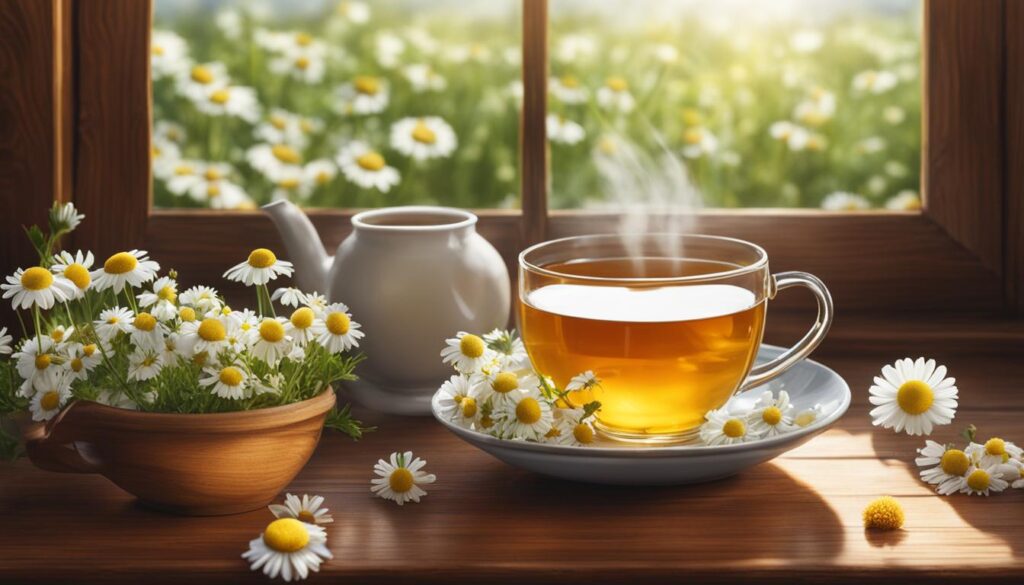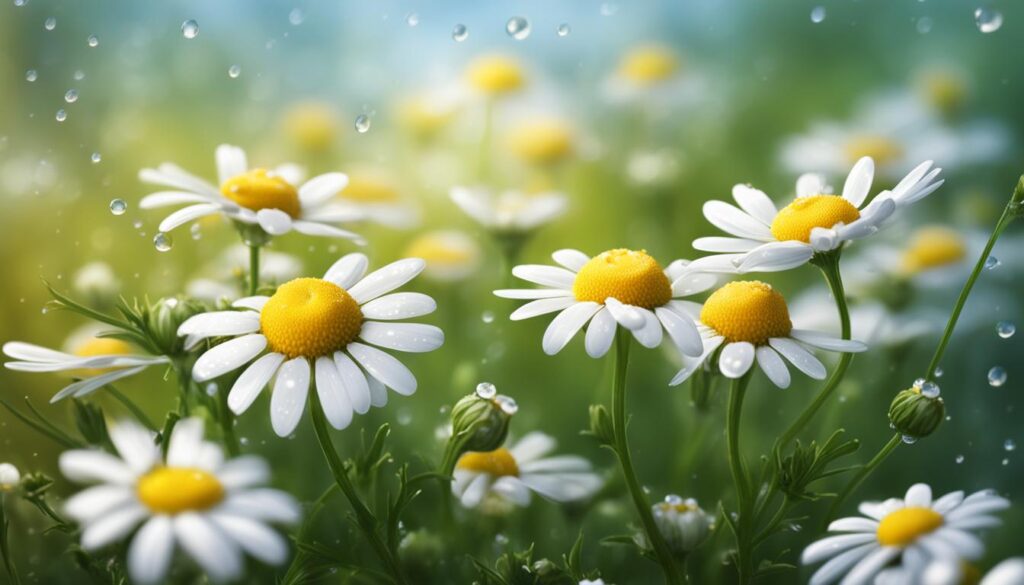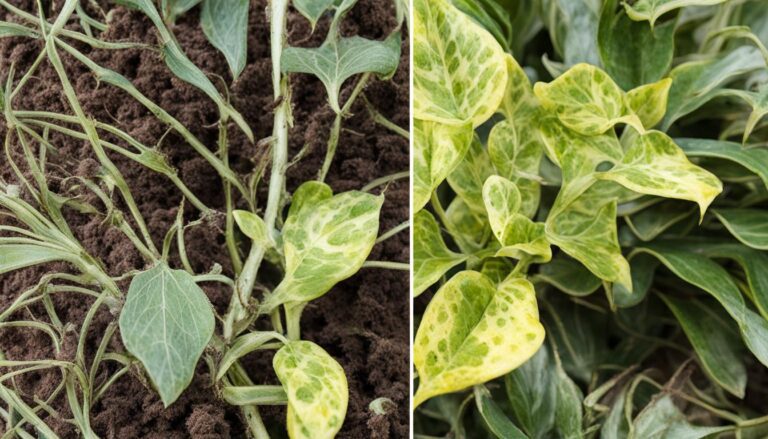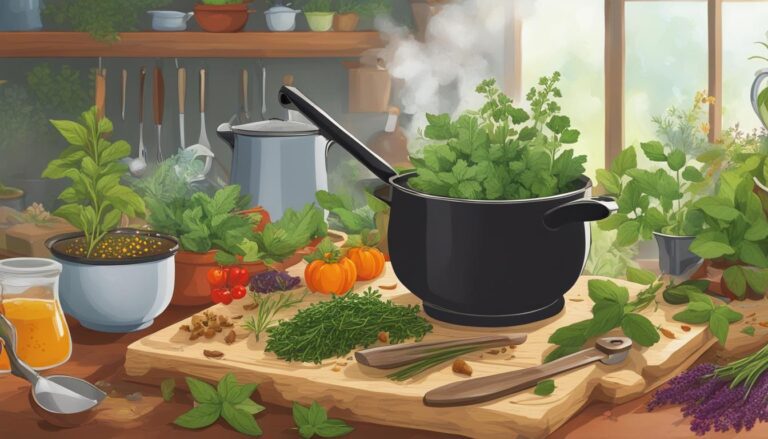
Chamomile, an annual herb in the daisy family, is widely known for its medicinal properties and is commonly used in herbal remedies. Whether you have an herb or vegetable garden, or even ornamental beds and borders, growing chamomile at home is a rewarding experience.
With its preference for full sun and well-drained soil, chamomile can be easily cultivated and harvested for its numerous health benefits.
Key Takeaways:
- Chamomile is an annual herb used for medicinal purposes.
- It can be grown in herb or vegetable gardens, or integrated into ornamental beds and borders.
- Chamomile prefers full sun and well-drained soil.
- It can be propagated from seed and harvested when the flowers are near full bloom.
- Chamomile has many health benefits and can be used in various herbal remedies.
Types of Chamomile: German Chamomile vs Common Chamomile
When it comes to chamomile, there are two main types that are commonly used for medicinal purposes: German chamomile (Matricaria recutita) and common chamomile (Chamaemelum nobile). While both types share similar properties, there are some key differences between them.
German Chamomile
German chamomile is an annual herb native to Europe and western Asia. It is known for its vibrant yellow and white flowers and is widely used for making chamomile tea. German chamomile is particularly prized for its high concentration of essential oils, which give it a distinct and potent flavor.
Common Chamomile
On the other hand, common chamomile, also known as Roman chamomile, is a perennial herb that spreads by creeping, rooting stems. It has smaller, daisy-like flowers with a light, apple-like fragrance. Common chamomile is often used in lawns and as ground cover, but it can also be used to make herbal teas.
Both types of chamomile can be used to make teas, but German chamomile is more commonly used due to its stronger flavor and higher essential oil content. However, common chamomile can still be enjoyed as a more mild and aromatic alternative.
Chamomile Tea Recipe
One of the most popular ways to enjoy chamomile is by making a soothing cup of chamomile tea. Here’s a simple recipe to follow:
- Boil water in a kettle or saucepan.
- In a teapot or mug, add a handful of dried chamomile flowers or a chamomile tea bag.
- Pour the boiling water over the chamomile flowers or tea bag.
- Let it steep for about 5-10 minutes to release the flavors and properties of the chamomile.
- Remove the flowers or tea bag and enjoy your warm and comforting chamomile tea.
You can also add a squeeze of lemon or a drizzle of honey to enhance the taste if desired.
| Type of Chamomile | Botanical Name | Characteristics | Common Uses |
|---|---|---|---|
| German Chamomile | Matricaria recutita | Vibrant yellow and white flowers, strong flavor | Making chamomile tea, herbal remedies |
| Common Chamomile | Chamaemelum nobile | Smaller flowers, light apple-like fragrance | Ground cover, making chamomile tea |
Health Benefits of Chamomile
Chamomile is a versatile herb that offers numerous health benefits and is widely used in herbal medicine. Its anti-inflammatory properties make it effective in reducing inflammation and relieving pain.
Chamomile also has calming and soothing effects on the body, making it an excellent remedy for stress and anxiety. The herb can be consumed in the form of tea, tinctures, or capsules to promote relaxation and improve sleep quality.
In addition to its calming effects, chamomile has digestive benefits. It can help relieve stomachaches, indigestion, and bloating. The herb has been used for centuries to aid digestion and promote healthy gut function. Chamomile tea, in particular, can be consumed after meals to ease digestion and alleviate gastrointestinal discomfort.
Chamomile is also known for its skincare benefits. It can be used topically to soothe skin irritations, such as rashes, burns, and eczema. The anti-inflammatory properties of chamomile help reduce redness and inflammation, while its antiseptic properties promote wound healing.
Chamomile essential oil can be diluted and applied to the skin or added to bath products for a calming and rejuvenating experience.
| Health Benefits of Chamomile | Description |
|---|---|
| Relieves stress and anxiety | Chamomile has a calming effect on the nervous system, reducing stress and anxiety levels. |
| Improves sleep quality | Chamomile helps promote better sleep by relaxing the body and mind. |
| Aids digestion | Chamomile soothes the digestive system, relieving stomachaches, indigestion, and bloating. |
| Soothes skin irritations | Chamomile can be used topically to soothe rashes, burns, and eczema. |
| Promotes wound healing | Chamomile’s antiseptic properties help promote faster healing of wounds and cuts. |
Overall, chamomile is a powerful herb with a wide range of health benefits. Whether consumed as a tea or used topically, chamomile can provide relief from various ailments and promote overall well-being.

Growing Chamomile: Tips and Techniques
When it comes to growing chamomile at home, there are a few key tips and techniques that can help ensure success. Chamomile is an easy-to-grow herb that thrives in full sun and well-drained soil.
Whether you’re planning to cultivate chamomile in your herb garden or integrate it into your ornamental beds and borders, here are some essential cultivation tips to keep in mind:
- Choose the right location: Chamomile prefers full sun, so select a spot in your garden that receives at least 6-8 hours of direct sunlight each day. Additionally, make sure the soil is well-drained to prevent waterlogging, which can cause root rot.
- Start from seeds: Chamomile can be easily propagated from seeds. You can sow the seeds directly in the garden or start them indoors and later transplant them outdoors. Sow the seeds in early spring or fall for optimal results.
- Water regularly: Chamomile plants require regular watering to keep the soil moist but not overly wet. Water consistently to maintain the right moisture level, especially during dry spells or hot summer days.
- Harvest at the right time: For the best quality and potency, harvest chamomile flowers when they are near full bloom. Pick the flowers in the morning after the dew has evaporated but before the heat of the day sets in.
By following these cultivation tips and techniques, you can grow healthy and vibrant chamomile plants right in your own backyard. Whether you’re a seasoned gardener or a beginner, chamomile is a rewarding herb that adds beauty and health benefits to any garden.
| Tips for Growing Chamomile | Details |
|---|---|
| Location | Full sun and well-drained soil |
| Propagation | Start from seeds, sow directly or start indoors |
| Watering | Keep the soil moist but not wet |
| Harvesting | Pick flowers when near full bloom |
Harvesting and Using Chamomile
When it comes to chamomile, timing is everything. The optimal time to harvest chamomile is when the flowers are near full bloom. This is when the plant’s essential oils and active compounds are at their highest concentration. To harvest chamomile, simply snip off the flower heads with a pair of sharp scissors or garden shears. The flowers can be used fresh or dried for later use.
Chamomile can be used in various herbal remedies and products, making it a versatile addition to any natural medicine cabinet. One popular use for chamomile is in teas.
Chamomile tea is known for its calming and soothing properties, making it a great choice for promoting relaxation and relieving stress. To make chamomile tea, steep a handful of chamomile flowers in hot water for about 5-10 minutes. The tea can be enjoyed hot or cold and can be sweetened with honey or lemon, if desired.
In addition to teas, chamomile can also be used in tinctures, ointments, bath products, and aromatherapy. The essential oils extracted from the chamomile flowers have anti-inflammatory and antibacterial properties, making them useful for soothing skin irritations and promoting wound healing.
Chamomile essential oil can be added to massage oils, bath products, and skincare products for a calming and rejuvenating effect.
Uses of Chamomile
| Application | Uses |
|---|---|
| Teas | Calming, promoting relaxation, relieving stress |
| Tinctures | Internal use for digestive issues, anxiety, and insomnia |
| Ointments | Topical application for soothing skin irritations and promoting wound healing |
| Bath Products | Relaxing and therapeutic baths |
| Aromatherapy | Promoting relaxation, relieving stress |
With its wide range of uses and gentle yet effective properties, chamomile is a valuable herb for those seeking natural remedies and overall well-being.
The Perfect Chamomile Tea Recipe
Chamomile tea is not only delicious and soothing but also incredibly easy to make at home. With just a handful of chamomile flowers and some hot water, you can enjoy a warm cup of this herbal infusion any time of day. Here’s a simple recipe to help you brew the perfect cup of chamomile tea:
- Start by gathering a handful of fresh chamomile flowers. These can be harvested from your own chamomile plant or purchased from a local herbalist or health food store.
- Boil some water in a teapot or kettle. For one cup of chamomile tea, you’ll need about 8 ounces (240 milliliters) of water.
- Once the water has reached a rolling boil, turn off the heat and add the chamomile flowers to the pot. Cover and let steep for 5-10 minutes.
- After the steeping time, strain the tea into your cup using a fine-mesh strainer or tea infuser. If desired, you can add a teaspoon of honey or a squeeze of lemon for added flavor.
Sip and enjoy the mild, pleasant taste of chamomile tea as you relax and unwind. You can also refrigerate the tea and serve it chilled over ice for a refreshing summer drink. Chamomile tea can be enjoyed any time of day and is especially soothing before bedtime to promote relaxation and a good night’s sleep.

Chamomile Tea Benefits
In addition to its delightful flavor, chamomile tea offers a range of health benefits. It is known for its calming properties, making it a popular choice for relieving stress and anxiety.
Chamomile tea can also aid in digestion, soothe an upset stomach, and relieve menstrual cramps. It has anti-inflammatory properties and can help reduce skin irritations and promote wound healing when used topically.
So the next time you find yourself in need of a comforting and relaxing beverage, why not try brewing a cup of homemade chamomile tea? It’s a simple and natural way to enjoy the incredible benefits of this wonderful herb.
Chamomile Essential Oil Uses
Chamomile essential oil, derived from the flowers of the chamomile plant, offers a wide range of uses and benefits. This aromatic oil has been used for centuries in various forms of alternative medicine and skincare. With its anti-inflammatory, antibacterial, and calming properties, chamomile essential oil is a versatile addition to any natural remedy collection.
One of the primary uses of chamomile essential oil is in aromatherapy. Its soothing scent helps to promote relaxation, reduce stress, and improve sleep quality. Simply add a few drops of chamomile essential oil to a diffuser or mix it with a carrier oil for a calming massage oil.
Chamomile essential oil is also highly regarded for its skincare benefits. It can be used topically to soothe skin irritations, such as eczema or sunburns, and promote wound healing. Additionally, its anti-inflammatory properties make it an excellent choice for reducing redness and inflammation associated with acne.
Chamomile Essential Oil Uses
| Use | Benefits |
|---|---|
| Aromatherapy | Promotes relaxation, reduces stress, improves sleep quality |
| Skincare | Soothes skin irritations, promotes wound healing, reduces inflammation |
| Massage | Relieves muscle tension, eases soreness |
| Haircare | Conditions and nourishes the scalp, promotes healthy hair growth |
In addition to its use in aromatherapy and skincare, chamomile essential oil can also be added to haircare products. It conditions and nourishes the scalp, promoting healthy hair growth. Mix a few drops of chamomile essential oil with your favorite carrier oil and apply it to your scalp as a soothing and stimulating treatment.
When using chamomile essential oil, it’s important to dilute it properly with a carrier oil to avoid skin irritation. Popular carrier oils include coconut oil, almond oil, and jojoba oil.
Always perform a patch test before applying the oil to a larger area of the body and consult with a healthcare professional if you have any concerns or pre-existing medical conditions.

Chamomile in Traditional Medicine
Chamomile has been a staple in traditional medicine for centuries, renowned for its numerous health benefits and healing properties. This versatile herb is known for its calming and soothing effects, making it a popular choice for promoting relaxation, relieving stress, and aiding in sleep. Chamomile is also used to treat digestive problems, such as indigestion and stomach cramps.
One of the key uses of chamomile in traditional medicine is for its anti-inflammatory properties. It can help reduce inflammation in the body, making it useful for treating conditions such as arthritis and skin irritations. Chamomile is also known for its antibacterial properties, which can aid in wound healing and prevent infections.
Furthermore, chamomile’s therapeutic effects are not just limited to internal use. It can be applied topically to soothe skin irritations, such as eczema and psoriasis. The gentle nature of chamomile makes it suitable for all skin types, including sensitive skin. Many skincare products, including creams, ointments, and balms, contain chamomile extract for its calming and nourishing benefits.
Chamomile in Traditional Medicine
| Condition | Treatment |
|---|---|
| Stress and anxiety | Chamomile tea or supplements |
| Indigestion | Chamomile tea or tincture |
| Skin irritations | Chamomile-infused creams or ointments |
| Wound healing | Chamomile essential oil or poultice |
It’s important to note that while chamomile is generally safe for most people, individuals with allergies to plants in the daisy family may experience adverse reactions. It’s always recommended to consult with a healthcare professional before using chamomile, especially if you have any pre-existing medical conditions or are taking medications.
Chamomile continues to be a valuable herb in traditional medicine, cherished for its holistic approach to healing and well-being. Whether enjoyed as a soothing tea, applied topically, or taken in supplement form, chamomile offers a natural and effective way to promote health and overall wellness.
Potential Side Effects and Precautions
While chamomile is generally considered safe for most people, it is important to be aware of potential side effects and take necessary precautions when using it as a remedy.
Some individuals may experience allergic reactions, such as skin rashes or difficulty breathing, after coming into contact with chamomile. If you have a known allergy to plants in the daisy family, including ragweed, chrysanthemums, and marigolds, it is advisable to avoid chamomile.
It is also important to consult with a healthcare professional before using chamomile, especially if you have any pre-existing medical conditions or are taking medications. Chamomile may interact with certain medications, including blood thinners, sedatives, and anti-anxiety drugs.
Your healthcare provider can provide personalized guidance on whether chamomile is safe for you and how it may interact with your current medications.
Additionally, it is important to use chamomile in moderation and follow recommended dosage guidelines. Using excessive amounts of chamomile may lead to drowsiness, dizziness, or upset stomach.
If you experience any adverse effects or have concerns about using chamomile, it is best to discontinue use and consult with a healthcare professional.
- Some individuals may experience allergic reactions to chamomile, especially if they have known allergies to plants in the daisy family.
- Consult with a healthcare professional before using chamomile if you have pre-existing medical conditions or are taking medications, as it may interact with certain drugs.
- Use chamomile in moderation and follow recommended dosage guidelines to avoid potential side effects such as drowsiness, dizziness, or upset stomach.
| Side Effects | Precautions |
|---|---|
| Allergic reactions (skin rashes, difficulty breathing) | Avoid chamomile if you have known allergies to plants in the daisy family |
| Interaction with medications | Consult with a healthcare professional before using chamomile if you have pre-existing medical conditions or are taking medications |
| Excessive use | Use chamomile in moderation and follow recommended dosage guidelines |
Chamomile is a versatile medicinal herb that offers numerous health benefits. Whether you’re looking to cultivate chamomile in your own garden or explore the various uses of chamomile as a medicinal herb, there are plenty of tips and techniques to consider.
Chamomile is easy to grow, preferring full sun and well-drained soil. It can be propagated from seed and harvested when the flowers are near full bloom for the best quality.
Once harvested, chamomile can be used in various forms, including teas, essential oils, and herbal remedies. Chamomile tea is one of the most popular options, offering a mild and pleasant taste.
It can be enjoyed hot or cold and is commonly used for its calming and soothing properties. Chamomile essential oil is another versatile option, offering aromatherapy benefits as well as a topical treatment for skin irritations and wound healing.
Throughout history, chamomile has been widely regarded for its healing properties. Traditional medicine has utilized chamomile for centuries to treat a variety of ailments, such as digestive problems, anxiety, and insomnia. With its calming and soothing effects, chamomile is a popular choice for those seeking natural remedies.
In conclusion, chamomile is a valuable addition to any herbal medicine collection. With its easy cultivation, numerous uses, and long history of medicinal benefits, chamomile offers a natural and effective solution for various health concerns. So why not consider growing chamomile at home and exploring the many ways to incorporate it into your daily routine?
References
Here are some references that can further expand your knowledge on this versatile medicinal herb:
1. Newman DJ, Cragg GM, Snader KM. Natural products as sources of new drugs over the period 1981–2002. J Nat Prod 2003; 66:1022-37. https://doi.org/10.1021/np030096l.
2. Koehn FE, Carter GT. The evolving role of natural products in drug discovery. Nat Rev Drug Discov 2005; 4:206-20. https://doi.org/10.1038/nrd1657.
3. Jones WP, Chin YW, Kinghorn AD. The role of pharmacognosy in modern medicine and pharmacy. Curr Drug Targets 2006; 7:247-64. https://doi.org/10.2174/138945006776054915.
4. Philip RB. Herbal remedies: the good, the bad, and the ugly. Med Clin North Am 2022; 106:881-98. https://doi.org/10.1016/j.mcna.2022.03.004.
5. Fabricant DS, Farnsworth NR. The value of plants used in traditional medicine for drug discovery. Environ Health Perspect 2001; 109 Suppl 1:69-75. https://doi.org/10.1289/ehp.01109s169.
These references can provide a deeper understanding of chamomile’s cultivation techniques, health benefits, remedies, and its use in herbal medicine.
FAQ
Is chamomile easy to grow?
Yes, chamomile is easy to grow and can be cultivated at home in herb or vegetable gardens, as well as integrated into ornamental beds and borders.
What type of soil and sunlight does chamomile prefer?
Chamomile prefers well-drained soil and full sun.
How can chamomile be propagated?
Chamomile can be propagated from seed.
When should chamomile be harvested?
Chamomile should be harvested when the flowers are near full bloom for the best quality.
What are the health benefits of chamomile?
Chamomile has anti-inflammatory properties, can help reduce stress and anxiety, aid in digestion, promote sleep, relieve menstrual cramps, soothe skin irritations, and promote wound healing.
How can chamomile be used in herbal remedies?
Chamomile can be used in teas, tinctures, ointments, bath products, and aromatherapy.
How can chamomile tea be made?
To make chamomile tea, steep a handful of chamomile flowers in hot water for about 5-10 minutes. The tea can be sweetened with honey or lemon, if desired.
What are the uses of chamomile essential oil?
Chamomile essential oil can be used in aromatherapy to promote relaxation and relieve stress, as well as topically to soothe skin irritations and promote wound healing.
How is chamomile used in traditional medicine?
Chamomile has been used in traditional medicine for centuries to treat various ailments, including digestive problems, anxiety, and insomnia.
Are there any side effects or precautions when using chamomile?
While chamomile is generally considered safe, some individuals may experience allergic reactions or other side effects. It is important to consult with a healthcare professional and use chamomile in moderation.







One Comment
Comments are closed.